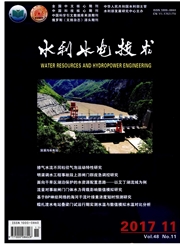

 中文摘要:
中文摘要:
本文以模型试验为依托,对折板消能竖井的流动型态、消能特征等的转捩特征及影响因素进行了分析,并对水力转捩点附近的弗氏数进行了计算,结果显示:随着折板间距及过流流量的增大,易引起流动型态从往复跌流向S型贴壁流的转变,伴随流动型态的转变,消能特征亦表现出转捩特征;当无量纲流量Q^*为0.020-0.060、无量纲折板间距h^*为0.40-0.85时,水力转捩点附近的弗氏数约为2.60。在上述分析的基础上,推导了Q^*为0.020-0.060、h^*为0.40-0.85时折板间距取值需满足的参数关系式,经检验,该关系式可良好地反映竖井中的水力特性且与试验及应用实例符合良好,因此可为折板间距的确定提供技术参考。
 英文摘要:
英文摘要:
Based on the relevant model test, the transition characteristics of the flow pattern and the energy dissipation feature as well as the influence factors of the baffle-drop shaft are analyzed herein, while the Froude number near the transition point is also calculated. The results show that the transformation of the flow pattern from the reciprocating-drop flow to the" S"-shaped wall- pressing flow is prone to be formed along with the increase of the baffle spacing and the flow discharge. Following with the transformation of the flow pattern, the energy dissipation feature also presents a transition feature. When the dimensionless flow rate Q ^* is in a range of 0. 020 - 0. 060 and the dimensionless baffle spacing h^*is in the range of 0. 40 - 0. 85, the Froude number is about 2. 60. On the basis of the analysis mentioned above, the parameter relationship that must be fulfilled by the value range of the baffle spacing when Q ^* = 0. 020 - 0. 060 and h ^* = 0. 40 - 0. 85 is derived. Through the relevant verification, the relationship can better reflect the hydraulic characteristics in the shaft and coincide with the test and the actual application case, thus can provide a technical reference for determining the baffle spacing as well.
 同期刊论文项目
同期刊论文项目
 同项目期刊论文
同项目期刊论文
 期刊信息
期刊信息
